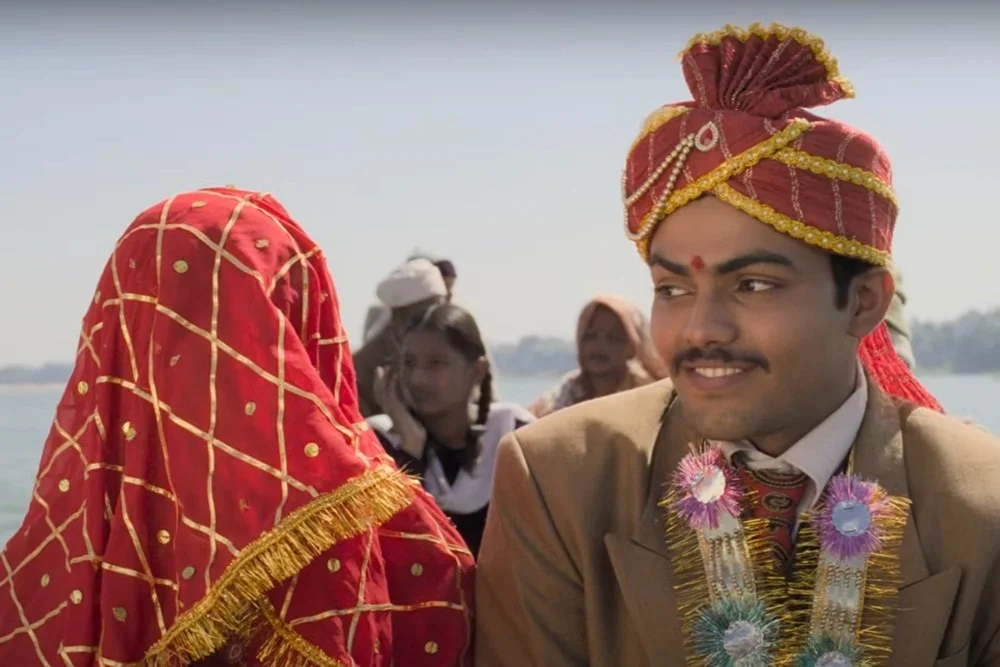Gone Girls
Told through the prism of a Shakesperean comedy of errors and mistaken identities, Kiran Rao’s Laapata Ladies (2024) explores the various paths to female self-determination in rural India.
The opening shot of Laapata Ladies (2024) presents a scene of pure terror, juxtaposed somewhat with a whimsical, celebratory background score. Here is a Phool Kumari, a girl too young to have lived enough of a life to call her own. Her eyes plead for relief, her gaze shirks with confusion. Or anxiety, or horror. Her mouth gasps, right before it is stuffed with sweet laddoo.
It’s her wedding day.
Played by the teenaged actress Nithanshi Goel, Phool looks up at the grown-ups with dread, for the adulthood about to be thrust upon her. The elder women of the household cry—tears of farewell, joy, or fear. Phool is barely able to swallow the laddoo of celebration. She breaks into tears as she is shrouded under veil of her red bridal outfit. She is told by a woman to watch her step as she follows behind her groom. “Ek baar ghoonghat le liya, toh aage nahi, neeche dekhar chalna seekho”. Once you’ve adorned the veil, learn to walk with your eyes held low.
Deepak and Phool share their compartments with a couple more newlyweds, including two more brides similarly veiled under their red disguises. Phool is now simply one of them, another anonymous woman with no individual identity of her own, a mere companion by her husband’s side.
The groom Deepak (Sparsh Shrivastav), meanwhile, beams with joy, like a child finally granted his favourite toy. Once the ceremony is over, he must lead the veiled figure of Phool home with him across nondescript parts of Nirmal Pradesh, a fictional state somewhere in the heartland of India. They travel on the back of a three-person scooter, a boat, the rooftop of a small bus, and finally, a train, where Deepak and Phool share their compartments with a couple more newlyweds, including two more brides similarly veiled under their red disguises.
Phool is now simply one of them, another anonymous woman with no individual identity of her own, a mere companion by her husband’s side. None of the women speak up or peek out; in silence, they hear the passengers discuss their newfound booty—and the dowries they’ve won in the process.
It’s at this point that Laapata Ladies—just the second directorial venture by Kiran Rao and her first since the memorable Dhobi Ghat (2011)—steers into truly absurd territory. When he is awoken to his destination in the train at night, Deepak hastily gathers his belongings, shakes awake a woman under the bridal veil, and steps out to the platform. Another bus takes him and the woman to his village, where the new groom is greeted back home with fanfare by his family and friends. The woman follows, straggling behind like a mute accessory, her presence reduced to almost an afterthought in the celebration.
No prizes for guessing what happens next. The woman behind the veil is not Phool but “Pushpa”—later revealed as Jaya (Pratibha Ranta). Written by Biplab Goswami, Laapata Ladies proceeds now as a Shakespearean black comedy, of two brides misplaced through a comedy of errors, laden with themes of identity, love, death, and much melodrama. While Jaya is temporarily adopted by Deepak’s discomforted family, Phool ends up deboarding at Pateela station with Jaya’s new husband Pradeep, an angry young man more intent on punishing Jaya for her disappearance rather than concern for her well-being. Phool, still adorned in her wedding outfit, hides in the railway station. It’s a frightening new place in a strange new city for a young girl who can’t explain where she came from—or where she is supposed to go.
Laapata Ladies is set in 2001, an era before ease-of-connectivity and internet ubiquity. As a rarity in mainstream cinema, the film is also free of cosmopolitan Indian life, refusing to fit into the mould of box office hits or demands of streaming giants catering to an urban audience. Still, the film exceeded box office expectations in cinemas, followed by positive word-of-mouth buzz upon its Netflix release in April.
Phool is a lost child, incapable to trace the complicated roadmap back to her family, and unable to recall the name of her husband’s village. She is now a nowhere woman, stuck on the platform, a literal junction of her life between the home of her past and the home of her future. At the Pateela station, she meets Manju Maai (Chhaya Kadam), an elder woman who runs a tea/snacks stall by the platform, and, through a litany of grimaces, grunts, and scoldings, slowly adopts Phool into her life. Manju’s character serves as the framework of female self-dependence, as she stresses the importance of shedding behind the systems of patriarchy that have kept the young bride ignorant, unable to chart her own course without the guidance of a ‘man of the house’: a father, a husband. Manju reprimands Phool for being trained with only the skills of a homemaker, to satisfy the needs of her husband rather than her own, and reminds her of her own potential as a woman—independent of the men in her life.
While Phool suffers for her ignorance, Jaya—a little older, a little more confident—uses the perception of ignorance to her advantage. From her real name to her ulterior motives, Jaya is clearly hiding something; but when she’s unable to recall details about her hometown or her new husband’s contact information, the people around her don’t hesitate to give her the benefit of the doubt. The presumption here is: aren’t all such young women trained to be helpless on their own?
Now the ‘mistaken’ bride, Jaya finds herself in an unusual role within the traditional Indian household. Since she is not Deepak’s bride and the new bahu (daughter-in-law) in the family, there is no expectation for her to behave like a bahu. She can unveil herself outside the house if she so wishes, be free to explore around town, speak out of turn, and say the name of ‘her man’ out aloud. There is obvious tension between Deepak’s own sister-in-law, his mother, and his grandmother, generational trauma passed on by women to women in the patriarchal system. But Jaya—who is supposed to be the ‘responsibility’ of another household—has no obligation to adhere to their systems of hierarchy.
Allowing many of its characters a shot at redemption, Laapata Ladies remains largely an optimistic film. It skims gently over the deeper, darker abyss of everyday horrors faced by women to land safely on the other side.
At the heart of the story are the new relationships that Rao’s women are confronted with, outside of their prescribed role in patriarchal communities. In Deepak’s household, for example, the women play the roles of mother, grandmother, wife, sister-in-law—but not of a friend. Jaya’s unconventional place in this set-up allows her to be a friend to these women. It is here that Yashoda (Deepak’s mother) asks her mother in-law, “Amma ji, agar hum aur tum dost hote toh?” (Could you and I be friends, too?). The mother-in-law giggles and responds. “Try karke dekhte hain!” (Let’s try!).
At the Pateela Station, Phool finds friendship, too, in both women and men, a friendship of larger community. These are some of the most wholesome moments in the film, where the kindness of strangers who live and work around the station help uplift the lost girl. In Manju Maai, Abdul, Chhotu, and the station master, Phool discovers that community can mean more than the family one is born into—or assigned to by marriage. Here, she is in a limbo between her past and her future, in the space between childhood and wifedom, where, for a brief moment in time, she doesn’t need to be anyone but herself.
And yet, it is marriage that Phool ultimately yearns for. Laapata Ladies presents multiple options for a woman’s prerogative: while Jaya reveals that she intentionally duped the police authorities to keep away from her husband and pursue an independent life at college, Phool realizes that she is in love with Deepak, that what she yearns for most is to see him again. There is a balance in Rao’s film, as both the laapata ladies find their way home: one chooses to find herself in marriage; the other, in her individual aspirations.
Rao extends this balance to the men in the film, too. By almost commodifying Phool as just another nameless woman behind a veil, Deepak commits the initial blunder of losing her. But his efforts to bring her back are based on a genuine, romantic love, rather than a pressure to adhere to social expectations. He is sensitive and unconcerned with the greedy boasts of dowry he hears from other grooms and mothers-in-law. He is a decent man who committed an indecent mistake—and spends much of the film suffering his error.
On the far extreme is Pradeep—Jaya’s new groom—an indecent man reeking of years of indecency, who carries himself with all the red flags of much more indecency to come. Jaya’s choice couldn’t be clearer: for her, marrying Pradeep would mean giving up on her own aspirations, and perhaps, giving up on joy altogether.
Allowing many of its characters a shot at redemption, Laapata Ladies remains largely an optimistic film. It skims gently over the deeper, darker abyss of everyday horrors faced by women to land safely on the other side. The comic tone keeps chugging the plot forward, in what is another Shakespearean tactic: using the absurdity of humour to shade over larger systematic absurdities. In her direction, Rao focuses on the beautiful, vibrant hues of India’s hinterlands, offering a happy glow of colours and sound even in moments of tension. Some of these frames are truly unforgettable, including the shot of Deepak and Phool straddled behind a third motorcycle driver in the village, or brides in red saris seated soundlessly under a faint bulb of a moving train at nighttime.
Despite its obviously good intentions, Laapata Ladies is more prescriptive than reflective of India’s rural life. The film wishes to teach Indian society how to behave, rather than presenting the truer reality, as it is. In that ‘truer’ reality, a woman’s autonomy would rarely be allowed to practice her autonomy in communities tied so closely to patriarchal systems. Elaborating on this further, Sumana Roy, in her review of the film, says that in Laapata Ladies, “handbook feminism defeats patriarchy with a cinematic ease that would be hard to imagine in rural India.”
It’s a valid observation, but films are fantasy after all, and the role of cinema—particularly in India—is the cultivation of fantasies at the grandest stage. It’s where we can hope and imagine a better world—even if only for a few hours.
By the end, the upbeat tone of the film all but promises this better world for its inhabitants. The motif of veiled women continues throughout the film, from the ghoonghat of newly-married Hindu brides to the burkha worn by Muslim women. But as Laapata Ladies progresses, these veils are lifted, both literally and figuratively, until each woman shines as an individual, with individual motivations. Each face is clear, distinct.
***
Karan Madhok is a writer, journalist, and editor of The Chakkar. His debut novel A Beautiful Decay (Aleph Book Company) was published in October 2022. His work has appeared in Epiphany, Sycamore Review, Gargoyle, The Literary Review, The Bombay Review, Fifty Two, Scroll, The Caravan, the anthology A Case of Indian Marvels (Aleph Book Company) and The Yearbook of Indian Poetry in English 2022 (Hawakal). You can find him on Twitter: @karanmadhok1, Instagram: @karanmadhok, and Threads: @karanmadhok.

